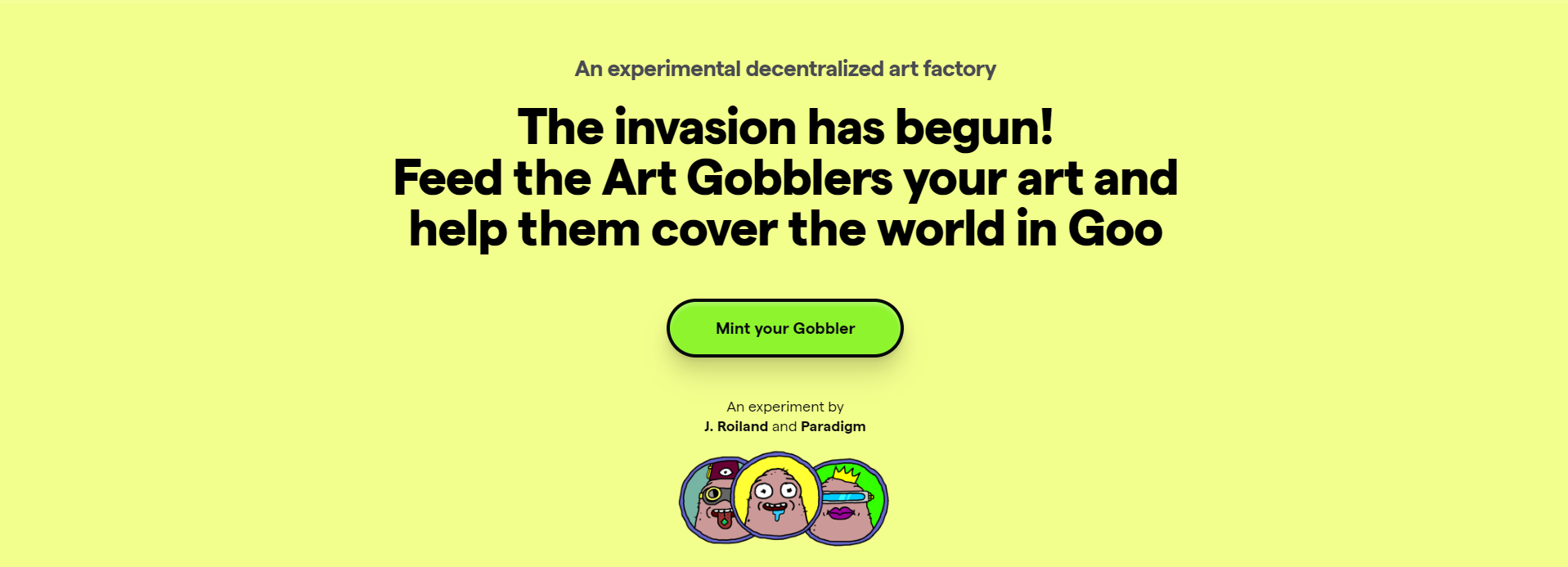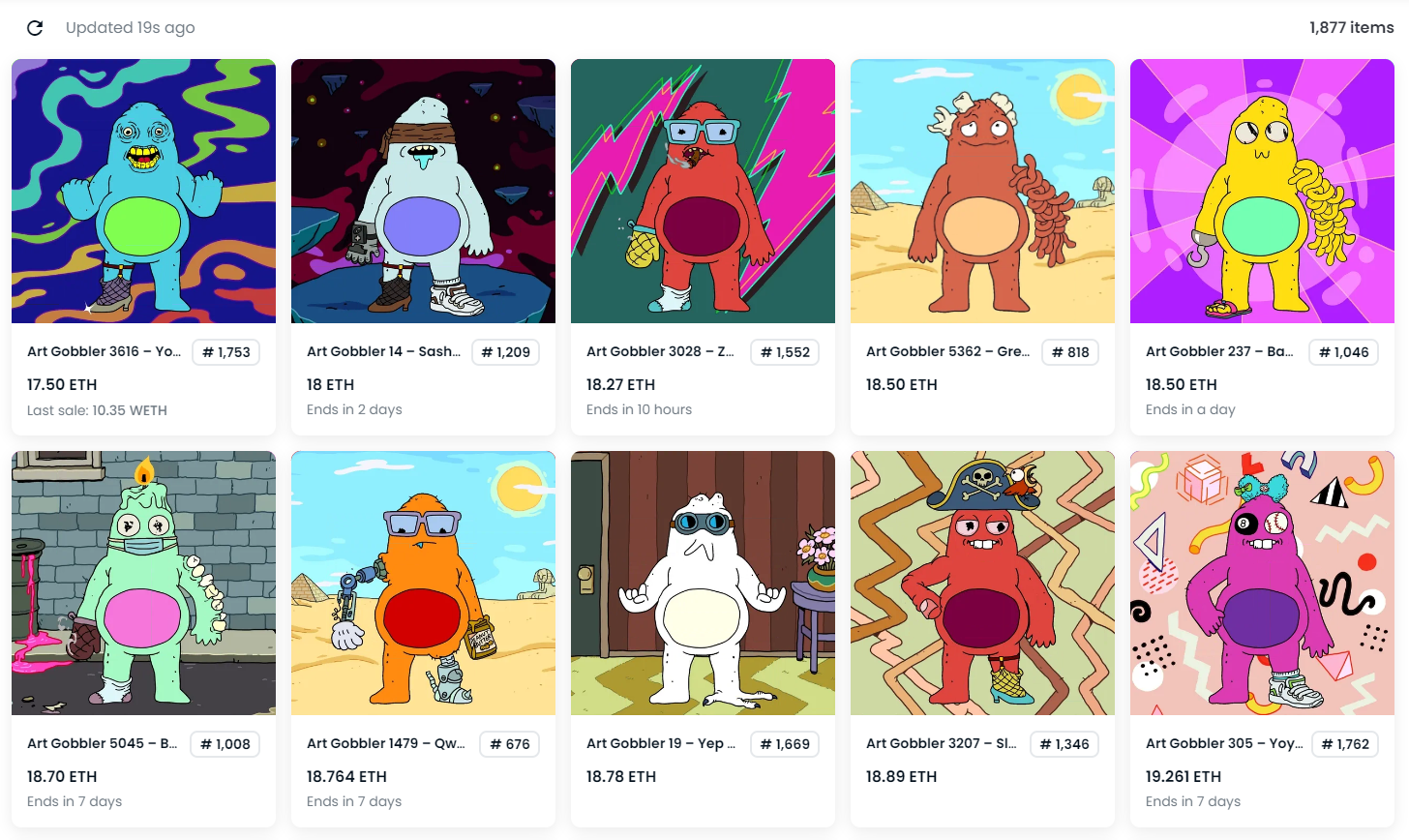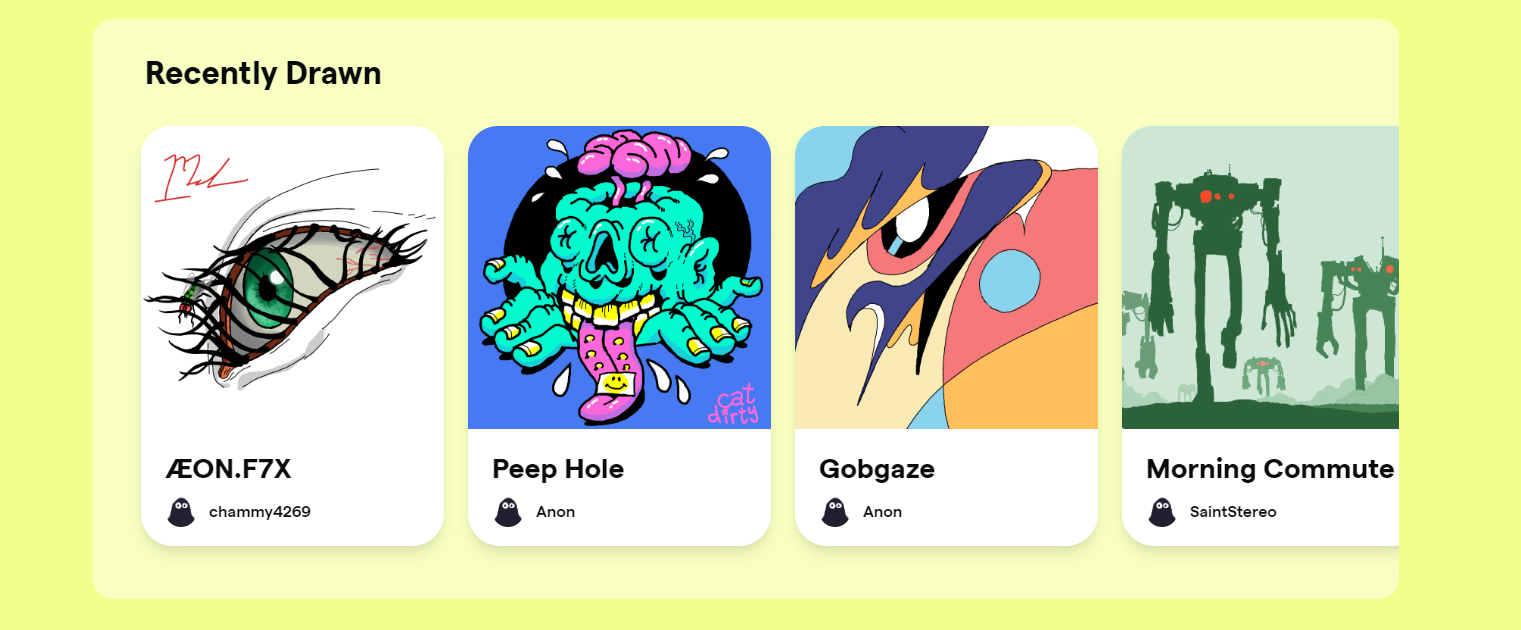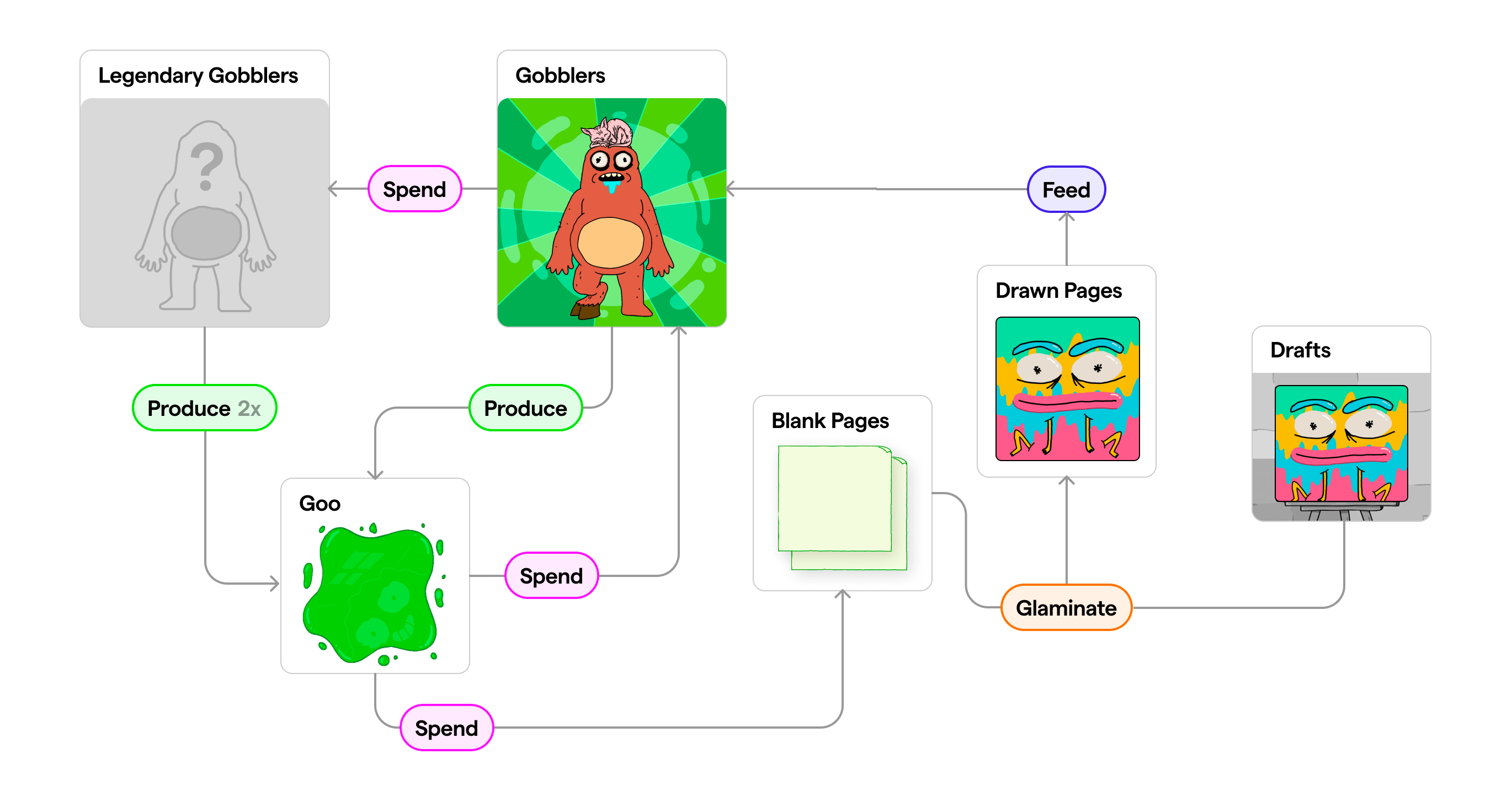Art Gobblers, an Ethereum NFT project from “Rick & Morty” co-creator Justin Roiland and Paradigm, launched Monday and saw skyrocketing secondary sales.
The project, now floor price sits at 17.5 ETH, generated more than 45M in trading volume, and rocketed into the top 10 list of projects for total ETH volume in October, barely an hour after minting out.
The project’s unique ideas, instant success, and controversy surrounding its allowlist process have made it a lightning rod for discussion and debate on Twitter.
So, what is this alien stuff all about?
It’s time. https://t.co/th7jZANTG5 pic.twitter.com/Aun6LZvtsq
— Art Gobblers (@artgobblers) October 31, 2022
What are Art Gobblers?

"Art Gobblers is an experimental decentralized art factory by Justin Roiland and Paradigm." - said the website.
Basically, Art Gobblers is a fresh Ethereum NFT project that focuses on art creation within its ecosystem, and they aim to change the NFT game. Art Gobblers' stated goal is to create a "decentralized art factory" using a combination of NFTs, a GOO token and community collaboration.
The NFTs themself are fully animated ERC721 NFTs. Their look came from the famous Rick & Morty co-creator, Justin Roiland. They have different random attributes or traits. They also have a built-in mechanism to evolve, they "gobble the art" and display it on their stomach (which is weird and innovative, I guess).
Art Gobblers NFT also has the power to produce GOO (ERC20 token). GOO token is basically in-game money that performs primarily in their ecosystem.
Apart from that, Art Gobblers came with a long academic whitepaper:
https://www.paradigm.xyz/2022/09/artgobblers
The whitepaper explains carefully how this alien project will disrupt the NFT game, which is another feature making this project go boom.

The Art Gobblers NFT collection launched on October 31 at 20:20 UTC with much hype and fanfare, exponentially surging above $20,000 in minutes. Surprisingly, it took less than an hour for Art Gobblers' volume to crack the top 10 in NFT collection volumes in October.
'@artgobblers is now in the top ten for total ETH volume in October despite only existing for 50 minutes. pic.twitter.com/gpDxjOnGVD
— NFTstatistics.eth (@punk9059) October 31, 2022
Art Gobblers launched 1,700 Gobbler artwork NFTs that could be minted for free by anyone who was added to an approved allowlist. Another 300 NFTs were reserved for project creators and contributors, with a further 8,000 Gobbler NFTs to be released gradually over the next 10 years.
At the time of writing, they have already generated over $32 million worth of secondary sales (per CryptoSlam) with nearly 1000 owners. Art Gobblers collection currently holds a floor price of 12.69 ETH (~$20k at the moment).
https://cryptoslam.io/art-gobblers
What makes Art Gobblers peculiarly?
The Creator
Art Gobblers are an NFT project by Justin Roiland, the American animator and co-creator of the Rick and Morty franchise, in partnership with crypto investment firm Paradigm.
The combination of the two can make any crypto fan jump on their feet.
Justin Roiland, which is especially popular among the crypto-native crowd, created the NFT as a fully animated piece of art with the solid Rick and Morty style. Not every NFT collection has the animation feature, in fact, most NFTs just stand still in their frame.
Paradigm added the technical stuff onto that piece of art. They make the NFT become more than just a "bored" digital picture with some number attached. They even release a whitepaper for the collection, which is also a rare thing to see in this space.

The NFT didn't stop there. The "gobble the art" mechanism incentivized artists to display their artwork on Gobblers' bellies, making you the new creator of the NFT. How cool is that?
New Model
Art Gobblers define themself as a "decentralized art factory". They centered around the artwork that they created with their own drawing tool. The essence is that Art Gobblers aims to create a self-sustaining NFT mini ecosystem capable of thriving on its own.

The 2,000 Gobblers from the project's free mint "gobble art," meaning they eat the art that artists draw using the project's draw tool. These drawings are then turned into 1-of-1 NFTs using in-project resources. The totality of the artworks that a Gobbler eats are stored on chain and will be displayed in its "belly gallery" forever. These drawing NFTs are ERC721 tokens that belong to the artists who create them and can be transferred or sold by the artist whenever they want.
The Gobbler NFTs also produce Goo tokens, which are used to make the blank pages required to create the art they consume. The more Goo a Gobbler has in its "tank," the more Goo it can create. This token is designed to grow without end, so the ecosystem can't be balanced by giving NFTs fixed prices in Goo. Instead, the Paradigm team has come up with something called a VRGDA, a type of Gradual Dutch Auction that adjusts prices over time, raising them when sales are frequent and lowering them when they are lagging.
Over the next ten years, “players,” as the project white paper calls them, will have to spend Goo to mint 8,000 more Gobblers. Members can obtain 10 1-of-1 Legendary Gobblers by burning large amounts of regular Gobbler NFTs, which encourages community-wide collaboration.
When NFT projects have a fungible token, the communities holding the NFT and the token often diverge over time.@FrankieIsLost, @transmissions11 and I built a mechanism for @artgobblers to disincentivize this divergence and fix it when it happens anyway.https://t.co/yuGre6VNSQ pic.twitter.com/p7tJSrLXmT
— Dave White (@_Dave__White_) September 6, 2022
A little bit confusing, but it can be summed up this way: the Gobblers' economy system runs on the ERC20 token, GOO. GOO is produced by the NFT and can be used to purchase new NFTs or blank pages, an essential material for creating the artwork. GOO is an inflation token that work perfectly fine if you are in its ecosystem, thanks to a new mechanism called the VRGDA. Basically, if you hold on to your NFT, you will always have your fair share of the GOO market, and if you do not possess any Gobblers, then buying GOO is a wrong decision.
Community
There is no roadmap for Art Gobblers. There is no future process, no Gobblers Metaverse or sort. It is launched as a finished product, and the faith of Art Gobblers lies in its artistic community.
By far, even though it is too soon to say, this community is the most active one I have ever seen. They keep pumping art after art to make this mini-ecosystem become the most vivid and lively project in the NFT space.
Attention, humans! The first Art Gobblers Page has been glaminated.
— Art Gobblers (@artgobblers) November 2, 2022
Art production has begun. https://t.co/8XPc89oG1t
Seeing an alien pumping Goo out of his back is not my thing. But staring at the artwork on his belly is a weird but interesting experience.
The Controversy
Amid the surge of secondary sales, Crypto Twitter lit up with viral tweets sharing lists of prominent NFT influencers, content creators, and personalities that had successfully minted one of the NFTs. Broadly, the initial reaction was negative, with some users claiming that it reflected the outsized benefits gained by influencers with a large audience.
Last Tweet (I hope)on Art Gobblers
— Pons Asinorum (@Pons_ETH) October 31, 2022
This image is flying all over NFT Twitter
I am not accusing anyone of impropriety
But many people (including me) think the NFT game is rigged
People won’t continue to play a game they think is rigged. Expect more folks to quit pic.twitter.com/LSIpZHCKIe
That list included widely-followed Twitter personalities like Rug Radio co-founder Farokh Sarmad, pseudonymous collector and creator Fxnction, frequent Twitter Spaces host and Devotion co-founder Andrew Wang, and pseudonymous influencer and content creator Zeneca.
According to a September tweet thread from Art Gobblers, the creators opted to “hand-pick” artists and Web3 builders to mint the NFTs, who in turn nominated others to join the list as well. Some minters tweeted that they had gained access simply by participating in the project’s Discord server.
Andrew Wang revealed that he had operated an “official Art Gobblers account” on Twitter based on a fictional character, with absolutely no promise of whitelisting but to be an artist.
fuck it, i'm proud of the work i did for art gobblers.
— andrew (@andr3w) November 1, 2022
the last 2 months, i ran an official art gobblers account, a fictional character created by Justin Roiland, Dave, and me. His name is Balthazar Crumps, and we created him with no promise of wl, but for me to be an artist. pic.twitter.com/XsAur9V54S
Fxnction is the only one of those influencers who immediately flipped and sold his Art Gobblers NFT. He claimed that he got on the allowlist by just joining the Discord server early.
While all your other influencers friends are tryna explain why they sold their free mint for 15 ETH in minutes, i will tell you 1 thing:
— fxnction (@fxnction) November 1, 2022
I got that shit and dumped it fast. Free $18k. You expect differently?🫡
Pseudonymous Web3 creator Loopify, for example, called out supposed “misinformation” and shared anonymous messages from minters who said that selling their NFT brought them life-changing money.
the wave of misinformation around art gobblers mint is not only affecting the team building it, but the reputation for minters too
— Loopify 🧙♂️ (@Loopifyyy) November 1, 2022
👉 here is a few dozen images of people who had their life changed by being picked for WL
debts paid, supporting parents, financial stability, etc. pic.twitter.com/DzvLevB9ny
Calls for influencers in the space to disclose when they’ve been given an allow list spot for promoting a project have grown increasingly strident due to the circumstances surrounding Art Gobblers’ emergence.
The Conclusion
The debate that follows will be an uncomfortable but important one. Art Gobblers isn’t the first project to attract such criticism, and it’s doubtful that it will be the last.
Regardless, the evolution of the project’s unique characteristics and experimental ideas will be fascinating to see. Innovation like this injects much-needed creativity and activity into the NFT space in the middle of a bear market. Controversy or not, that’s to be commended. If Art Gobblers can sustain its popularity and significance in Web3 long-term, that will be even more impressive.
We have a little talk on attention economy in the Goblin Town article, and here, Art Gobblers is another perfect example. Not only to crypto enthusiasts but to human nature, attention was the "bottleneck of human thought" that limits both what we can perceive in stimulating environments and what we can do. We drive into what gobblers are, what they do, and what critics they take.
To me, a person who is in this for the tech, Art Gobblers NFT is an adrenaline shot that had been missing since the bear market. Back in the day, NFT was an innovation that the whole industry was hungry for, then we had the Bored Ape exclusive club, then we have the free-mint Gobblins, and now, Art Gobblers. Observing this changing world is wonderful, in the bigger time frame, we are the innovation, we are the resistance, and "We're All going to Make It".
